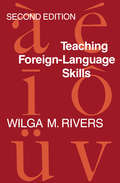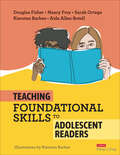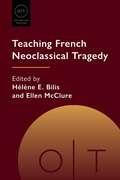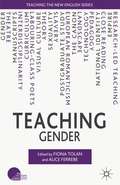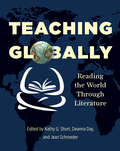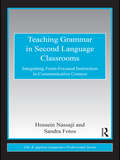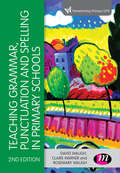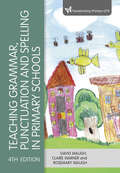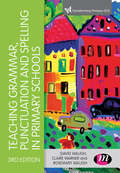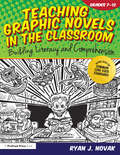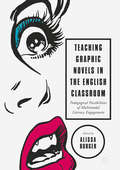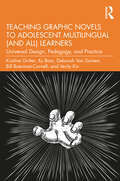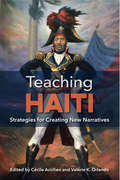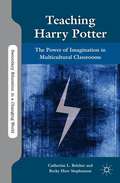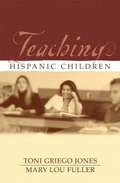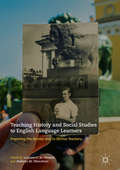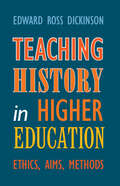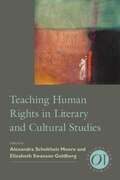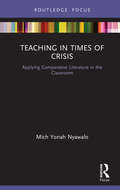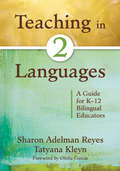- Table View
- List View
Teaching Foreign Language Skills
by Wilga M. RiversSince its original publication in 1968, Rivers's comprehensive and practical text has become a standard reference for both student teachers and veteran instructors. All who wish to draw from the most recent thinking in the field will welcome this new edition. Methodology is appraised, followed up by discussions on such matters as keeping students of differing abilities active, evaluating textbooks, using language labs creatively, and preparing effective exercises and drills. The author ends each chapter of this new edition with questions for research and discussion—a useful classroom tool—and provides an up-to-date bibliography that facilitates further understanding of such matters as the bilingual classroom.
Teaching Foundational Skills to Adolescent Readers
by null Douglas Fisher null Nancy Frey null Sarah Ortega null Kierstan Barbee null Aida Allen-RotellRecharge Adolescent Literacy: Strategies to Foster Joyful and Proficient Readers There are many adolescent readers who, for a variety of reasons, find it difficult to connect with written words and have fallen behind on their foundational reading skills. Thankfully, it’s never too late to give these necessary skills a boost and help students find joy in reading and learning. Armed with equity, empathy, evidence-based research, and practical application, Teaching Foundational Skills to Adolescent Readers provides classroom practices teachers can use with the whole class or with small groups to integrate reading support seamlessly with grade-level content learning. Bestselling authors Douglas Fisher and Nancy Frey, along with Sarah Ortega, Kierstan Barbee, and Aida Allen-Rotell, creatively organize the book around a metaphor: adolescent literacy is a battery—when all the parts are connected, working together, and fully charged—literacy can thrive. Throughout the book, the following features will guide your learning: Plug Into the Research – an overview of the evidence-based research supporting each section of the literacy model Power Up Classroom Practice – connecting the dots on the research, classroom practice and human aspects of learning Voices from the Field – classroom examples of application and strategies from other secondary educators Take Charge – key takeaways and reflection questions Tips on building and organizing your classroom library to incorporate tools, technology, and media available to maximize lesson effectiveness Dozens of videos to model time-efficient strategies and key concepts By focusing on research, classroom practices, and the human aspects of learning, this book is an essential tool to recharge reading practices for adolescent readers and help educators increase foundational reading skills in the classroom.
Teaching Foundational Skills to Adolescent Readers
by null Douglas Fisher null Nancy Frey null Sarah Ortega null Kierstan Barbee null Aida Allen-RotellRecharge Adolescent Literacy: Strategies to Foster Joyful and Proficient Readers There are many adolescent readers who, for a variety of reasons, find it difficult to connect with written words and have fallen behind on their foundational reading skills. Thankfully, it’s never too late to give these necessary skills a boost and help students find joy in reading and learning. Armed with equity, empathy, evidence-based research, and practical application, Teaching Foundational Skills to Adolescent Readers provides classroom practices teachers can use with the whole class or with small groups to integrate reading support seamlessly with grade-level content learning. Bestselling authors Douglas Fisher and Nancy Frey, along with Sarah Ortega, Kierstan Barbee, and Aida Allen-Rotell, creatively organize the book around a metaphor: adolescent literacy is a battery—when all the parts are connected, working together, and fully charged—literacy can thrive. Throughout the book, the following features will guide your learning: Plug Into the Research – an overview of the evidence-based research supporting each section of the literacy model Power Up Classroom Practice – connecting the dots on the research, classroom practice and human aspects of learning Voices from the Field – classroom examples of application and strategies from other secondary educators Take Charge – key takeaways and reflection questions Tips on building and organizing your classroom library to incorporate tools, technology, and media available to maximize lesson effectiveness Dozens of videos to model time-efficient strategies and key concepts By focusing on research, classroom practices, and the human aspects of learning, this book is an essential tool to recharge reading practices for adolescent readers and help educators increase foundational reading skills in the classroom.
Teaching French Neoclassical Tragedy (Options for Teaching #55)
by Hélène E. Bilis and Ellen McClureTragedy has been reborn many times since antiquity. Seventeenth-century French playwrights composed tragedies marked by neoclassical aesthetics and the divine-right absolutism of the Grand Siècle. But their works also speak to the modern imagination, inspiring reactions from Barthes, Derrida, and Foucault; adaptations and reworkings by Césaire and Kushner; and new productions by francophone and anglophone directors.This volume addresses both the history of French neoclassical tragedy--its audiences, performance practice, and development as a genre--and the ideas these works raise, such as necessity, free will, desire, power, and moral behavior in the face of limited choices. Essays demonstrate ways to teach the plays through a variety of lenses, such as performance, spectatorship, aesthetics, rhetoric, and affect. The book also explores postcolonial engagement, by writers and directors both in and outside France, with these works.
Teaching Gender
by Alice Ferrebe Fiona TolanEncompassing feminism, masculinities and queer theory, and drawing on film, literature, language, creative writing and digital technologies, these essays, from scholars experienced in teaching gender theory in university English programmes, offer inventive and student-focused strategies for teaching gender in the twenty-first century classroom.
Teaching Global Literature in Elementary Classrooms: A Critical Literacy and Teacher Inquiry Approach
by Kelly K. Wissman Maggie Naughter Burns Krista Jiampetti Heather O'Leary Simeen TabatabaiDemonstrating the power of teaching global literature from a critical literacy perspective, this book explores the ways that K-6 educators can infuse diverse texts into their classrooms and find support for their endeavours in teacher inquiry communities. Through carefully analyzed, ethnographically informed portraits of classroom life alternating with teachers’ own accounts of their teaching and learning experiences, it demonstrates how students are moved to question, debate, and take action in response to global texts. This multi-vocal work both emerges from and responds to tensions and debates related to the purpose and practice of literature education in a time of Common Core State Standards.
Teaching Globally: Reading the World through Literature
by Kathy Short Deanna Day Jean SchroederWith the world visibly present in students' lives through technology, mass and social medias, economic interdependency, and global mobility, it is more important than ever to develop curriculum that is intercultural. In Teaching Globally: Reading the World Through Literature, a community of educators show us how to use global children's literature to help students explore their own cultural identities. Edited by Kathy Short, Deanna Day, and Jean Schroder, this book explains why global curriculum is important and how you can make space for it within district and state school mandates. Teaching Globally is built around a curriculum framework developed by Short and can help teachers integrate a global focus into existing literacy and social studies curricula, evaluate global resources, guide students as they investigate cross-cultural issues, and create classroom activities with an intercultural perspective. Filled with vignettes from K-8 urban, suburban, and rural schools that describe successes and struggles, Teaching Globally aims to integrate global literature into classrooms and challenge students to understand and accept those different from themselves. The book also includes extensive lists of recommendations, websites, professional books, and an appendix of global text sets as mentioned by the authors. '
Teaching Grammar in Second Language Classrooms: Integrating Form-Focused Instruction in Communicative Context
by Hossein Nassaji Sandra S. FotosRecent SLA research recognizes the necessity of attention to grammar and demonstrates that form-focused instruction is especially effective when it is incorporated into a meaningful communicative context. Designed specifically for second-language teachers, this text identifies and explores the various options for integrating a focus on grammar and a focus on communication in classroom contexts and offers concrete examples of teaching activities for each option. Each chapter includes a description of the option, its theoretical and empirical background, examples of activities illustrating in a non-technical manner how it can be implemented in the classroom, questions for reflection, and a list of useful resources that teachers can consult for further information.
Teaching Grammar, Punctuation and Spelling in Primary Schools (Transforming Primary QTS Series)
by David Waugh Rosemary Waugh Claire WarnerHow do you teach grammar, punctuation and spelling in primary schools in a way that sparks children's interest? Trainee and beginning teachers often find the teaching of grammar, punctuation and spelling especially challenging as they are not confident in their own knowledge. This book explores and provides the subject knowledge you will need to teach grammar, punctuation and spelling and gives guidance on how to teach it. It helps you to build confidence in your own knowledge, opening up the subject and enabling them to approach teaching with ease. Examples of effective lessons show you how to engage children's interest in some of the more formal aspects of writing and throughout, activities and practical examples demonstrate how you can translate this learning into the classroom. About the Transforming Primary QTS Series This series reflects the new creative way schools are beginning to teach, taking a fresh approach to supporting trainees as they work towards primary QTS. Titles provide fully up to date resources focused on teaching a more integrated and inclusive curriculum, and texts draw out meaningful and explicit cross curricular links.
Teaching Grammar, Punctuation and Spelling in Primary Schools (Transforming Primary QTS Series)
by David Waugh Rosemary Waugh Claire WarnerTrainee and beginning teachers often find the teaching of grammar especially challenging. This popular text provides the subject knowledge you need to teach grammar, punctuation and spelling and explores how to teach it. Detailed examples of effective lessons show you how to engage children’s interest in some of the more formal aspects of writing. Throughout, activities and practical examples demonstrate how you can translate this learning for the classroom. This fourth edition has been updated to include new content on developing children′s vocabulary. A subject knowledge audit has been added to support you to assess your level of knowledge and confidence and to identify areas for development. All chapters are now linked to the CCF.
Teaching Grammar, Punctuation and Spelling in Primary Schools (Transforming Primary QTS Series)
by David Waugh Rosemary Waugh Claire WarnerTrainee and beginning teachers often find the teaching of grammar especially challenging. This popular text provides the subject knowledge you need to teach grammar, punctuation and spelling and explores how to teach it. Detailed examples of effective lessons show you how to engage children’s interest in some of the more formal aspects of writing. Throughout, activities and practical examples demonstrate how you can translate this learning for the classroom. This fourth edition has been updated to include new content on developing children′s vocabulary. A subject knowledge audit has been added to support you to assess your level of knowledge and confidence and to identify areas for development. All chapters are now linked to the CCF.
Teaching Grammar, Punctuation and Spelling in Primary Schools (Transforming Primary QTS Series)
by Rosemary Waugh Claire Warner David WaughTrainee and beginning teachers often find the teaching of grammar, punctuation and spelling especially challenging as they are not confident in their own knowledge. This popular text explores and provides the subject knowledge you will need to teach grammar, punctuation and spelling and gives guidance on how to teach it. The text is really accessible and includes lots of examples and teaching ideas, enabling you to approach teaching with ease. Detailed examples of effective lessons show you how to engage children’s interest in some of the more formal aspects of writing and throughout, activities and practical examples demonstrate how you can translate this learning into the classroom. This third edition has been updated to include more examples of children's work. A new chapter is added on 'Teaching grammar across the curriculum' to support an integrated approach to the teaching of grammar.
Teaching Grammar, Punctuation and Spelling in Primary Schools (Transforming Primary QTS Series)
by Rosemary Waugh Claire Warner David WaughTrainee and beginning teachers often find the teaching of grammar, punctuation and spelling especially challenging as they are not confident in their own knowledge. This popular text explores and provides the subject knowledge you will need to teach grammar, punctuation and spelling and gives guidance on how to teach it. The text is really accessible and includes lots of examples and teaching ideas, enabling you to approach teaching with ease. Detailed examples of effective lessons show you how to engage children’s interest in some of the more formal aspects of writing and throughout, activities and practical examples demonstrate how you can translate this learning into the classroom. This third edition has been updated to include more examples of children's work. A new chapter is added on 'Teaching grammar across the curriculum' to support an integrated approach to the teaching of grammar.
Teaching Graphic Novels in the Classroom: Building Literacy and Comprehension (Grades 7-12)
by Ryan J. NovakTeaching Graphic Novels in the Classroom describes different methods teachers may use to begin teaching graphic literature to new readers. The first chapter of the book is dedicated to the history of the medium and runs from the earliest days of comic books through the growing popularity of graphic novels. It includes profiles of early creators and the significance of certain moments throughout the history that chart the evolution of graphic literature from superheroes to award-winning novels like Maus. Chapters 2-8 focus on different genres and include an analysis and lessons for 1-2 different novels, creator profiles, assignments, ways to incorporate different media in connection with each book, chapter summaries, discussion questions, and essay topics. Chapter 9 is the culminating project for the book, allowing students to create their own graphic novel, with guidance from the writing process to creating the art.Grades 7-12
Teaching Graphic Novels in the English Classroom
by Alissa BurgerThis collection highlights the diverse ways comics and graphic novels are used in English and literature classrooms, whether to develop critical thinking or writing skills, paired with a more traditional text, or as literature in their own right. From fictional stories to non-fiction works such as biography/memoir, history, or critical textbooks, graphic narratives provide students a new way to look at the course material and the world around them. Graphic novels have been widely and successfully incorporated into composition and creative writing classes, introductory literature surveys, and upper-level literature seminars, and present unique opportunities for engaging students' multiple literacies and critical thinking skills, as well as providing a way to connect to the terminology and theoretical framework of the larger disciplines of rhetoric, writing, and literature.
Teaching Graphic Novels to Adolescent Multilingual (and All) Learners: Universal Design, Pedagogy, and Practice
by Kristine Gritter Xu Bian Deborah Van Duinen Bill Boerman-CornellThis book provides a roadmap for teaching with graphic novels as an effective and engaging approach to advancing reading comprehension for English Learners in secondary schools. Accessibly synthesizing and presenting existing graphic novel research, the authors walk through how to use graphic novels as a teaching tool to improve student motivation and key reading skills, increase their reading proficiency levels, and bolster their vocabulary. The authors provide curricular ideas for teaching multilingual, gifted, and striving readers, along with methods for developing critical literacy and multimodal comprehension. Applying a universal design approach and including examples, current graphic novel recommendations, and pedagogical strategies, this book is essential reading for pre-service teachers in TESOL and literacy education.
Teaching Haiti: Strategies for Creating New Narratives
by Cécile Accilien and Valérie K. OrlandoThis volume is the first to focus on teaching about Haiti’s complex history and culture from a multidisciplinary perspective. Making broad connections between Haiti and the rest of the Caribbean, contributors provide pedagogical guidance on how to approach the country from different lenses in course curricula. They offer practical suggestions, theories on a wide variety of texts, examples of syllabi, and classroom experiences. Teaching Haiti dispels stereotypes associating Haiti with disaster, poverty, and negative ideas of Vodou, going beyond the simplistic neocolonial, imperialist, and racist descriptions often found in literary and historical accounts. Instructors in diverse subject areas discuss ways of reshaping old narratives through women’s and gender studies, poetry, theater, art, religion, language, politics, history, and popular culture, and they advocate for including Haiti in American and Latin American studies courses. Portraying Haiti not as “the poorest nation in the Western Hemisphere” but as a nation with a multifaceted culture that plays an important part on the world’s stage, this volume offers valuable lessons about Haiti’s past and present related to immigration, migration, locality, and globality. The essays remind us that these themes are increasingly relevant in an era in which teachers are often called to address neoliberalist views and practices and isolationist politics. Contributors: Cécile Accilien | Jessica Adams | Alessandra Benedicty-Kokken | Anne M. François | Régine Michelle Jean-Charles | Elizabeth Langley | Valérie K. Orlando | Agnès Peysson-Zeiss | John D. Ribó | Joubert Satyre | Darren Staloff | Bonnie Thomas | Don E. Walicek | Sophie Watt
Teaching Harry Potter
by Catherine L. Belcher Becky Herr StephensonGiven the current educational climate of high stakes testing, standardized curriculum, and "approved" reading lists, incorporating unauthorized, often controversial, popular literature into the classroom becomes a political choice. The authors examine why teachers choose to read Harry Potter, how they use the books and incorporate new media, and the resulting teacher-student interactions. The book encourages a critical discussion regarding the state of our educational system and the increasing lack of space allowed for imagination and complexity. Its unique research methodology is part ethnographic, part practitioner research, and serves as an analytical commentary on current school culture and policy.
Teaching Hispanic Children
by Toni Griego Jones Mary Lou FullerThis book provides teachers with an understanding of how to teach Hispanic students effectively. After an overview of demographics and the role of national origins and cultural background in teaching and learning, the book examines the importance of teachers' understanding of their own attitudes about Hispanic students, and looks at language in the Hispanic community, implications of language differences in the classroom, cultural sensitivity, and Hispanic families.
Teaching History and Social Studies to English Language Learners
by Luciana C. de Oliveira Kathryn M. ObenchainThis book investigates the preparation of secondary history and social studies (SS) teachers to teach English language learners (ELLs) in twenty-first century classrooms. This edited collection focuses on the ways in which pre-service and in-service teachers have developed - or may develop - instructional effectiveness for working with ELLs in the secondary history and social studies classroom. The authors address a variety of standards and content examples, including the National Council for Social Studies C3 Framework and Curriculum Standards, the Common Core State Standards for English Language Arts, and content from history, geography, and civics. This volume is part of a set of four edited books focused on teaching the key content areas to English language learners.
Teaching History at University: Enhancing Learning and Understanding
by Alan BoothAlan Booth draws on a wide range of international research as well as the reflections and experiences of university historians, linking theory and practice. Teaching History at University examines how high-quality history teaching and learning can be achieved in today's universities worldwide. This is an essential resource for university teachers and all those who are responsible for ensuring the quality of teaching and learning policies and practices within their institutions.
Teaching History in Higher Education: Ethics, Aims, Methods
by Edward Ross DickinsonWhat are the distinctive characteristics of the discipline of history? How do we teach those characteristics effectively, and what benefits do they offer students? How can history instructors engage an increasingly diverse student body? Teaching History in Higher Education offers instructors an innovative and coherent approach to their discipline, addressing the specific advantages that studying history can bring. Edward Ross Dickinson examines the evolution of methods and concepts in the discipline over the past two hundred years, showing how instructors can harness its complexity to aid the intellectual engagement of their students. This book explores the potential of history to teach us how to ask questions in unique and powerful ways, and how to pursue answers that are open and generative. Building on a coherent ethical foundation for the discipline, Teaching History in Higher Education presents a range of concrete techniques for making history instruction fruitful for students and teachers alike.
Teaching Human Rights in Literary and Cultural Studies (Options for Teaching #38)
by The Modern Language Association of AmericaSince the adoption of the Universal Declaration of Human Rights of 1948, the discourse of human rights has expanded to include not just civil and political rights but economic, social, cultural, and, most recently, collective rights. Given their broad scope, human rights issues are useful touchstones in the humanities classroom and benefit from an interdisciplinary and cross-cultural pedagogy in which objects of study are situated in historical, legal, philosophical, literary, and rhetorical contexts. Teaching Human Rights in Literary and Cultural Studies is a sourcebook of inventive approaches and best practices for teachers looking to make human rights the focus of their undergraduate and graduate courses.Contributors first explore what it means to be human and conceptual issues such as law and the state. Next, they approach human rights and related social-justice issues from the perspectives of particular geographic regions and historical eras, through the lens of genre, and in relation to specific rights violations--for example, storytelling and testimonio in Latin America or poetry created in the aftermath of the Armenian genocide. Essays then describe efforts to cultivate students' capacity for ethical reading practices and to deepen their understanding of the stakes and artistic dimensions of human rights representations, drawing on active learning and experimental class contexts. The final section, on resources, directs readers to further readings in history, criticism, theory, and literary and visual studies and provides a chronology of human rights legal documents.
Teaching in Times of Crisis: Applying Comparative Literature in the Classroom (Routledge Studies in Comparative Literature)
by Mich Yonah NyawaloTeaching in Times of Crisis explores how comparative methods, which are instrumental in reading and teaching works of literature from around the world, also provide us with tools to dissect and engage the moments of crises that permeate our contemporary political realities. The book is written in the form of a series of classroom reflections—or memos—capturing the political environment preceding and proceeding the 2016 US presidential election. It examines the ways in which the ethics involved in reading comparatively can be employed by teachers and students alike to map and foster "lifelines for cultural sustainability" (to borrow the term from Djelal Kadir’s Memos from the Besieged City) that are essential for creating and maintaining a healthy multicultural society. Nyawalo achieves this through comparative readings of postcolonial films, LGBTQ texts, French slam poetry, as well as episodes from Star Trek: The Next Generation, among other materials. The classroom reflections captured in each memo are shaped by the Appalachian setting in which the discussions and lessons took place. Inspired by this setting, the author develops pedagogic ethics of comparison—a method of reading comparatively—which privileges the local educational spaces in which students find themselves by mapping the contested cultural politics of Appalachian realities onto a world literature curriculum.
Teaching in Two Languages: A Guide for K–12 Bilingual Educators
by Sharon Adelman Reyes Tatyana KleynGrounded in the latest research, this book provides classroom-ready strategies for balancing instruction in two languages and meeting the unique challenges of educating English language learners.
